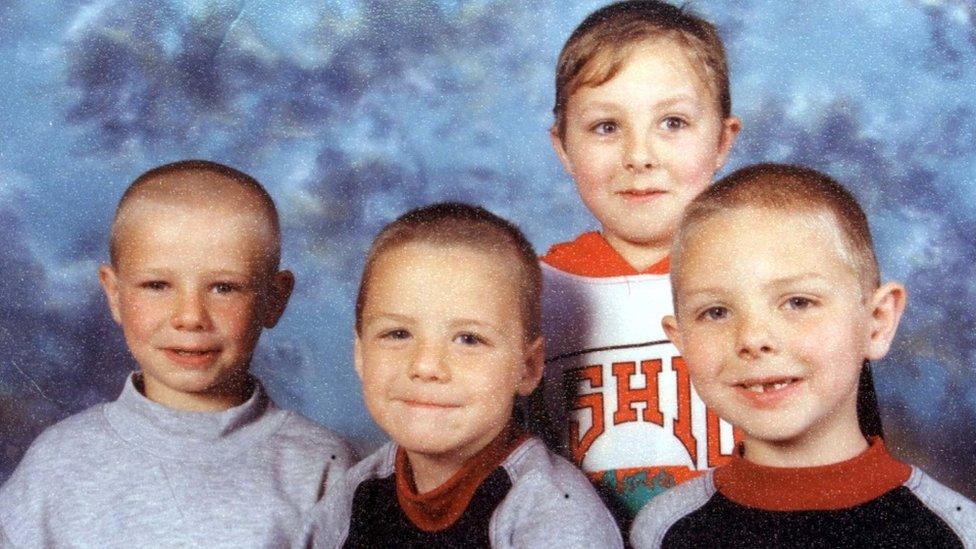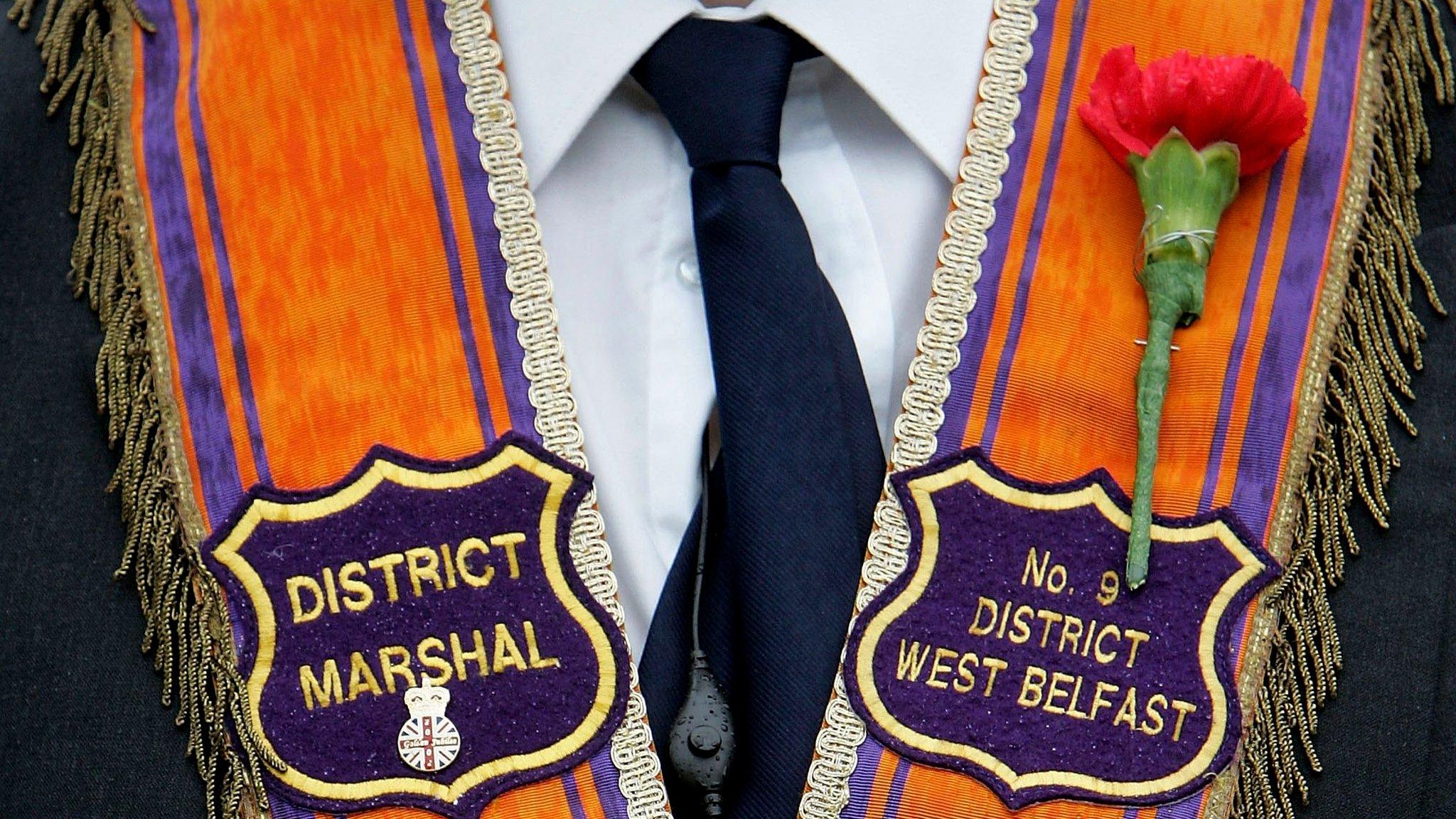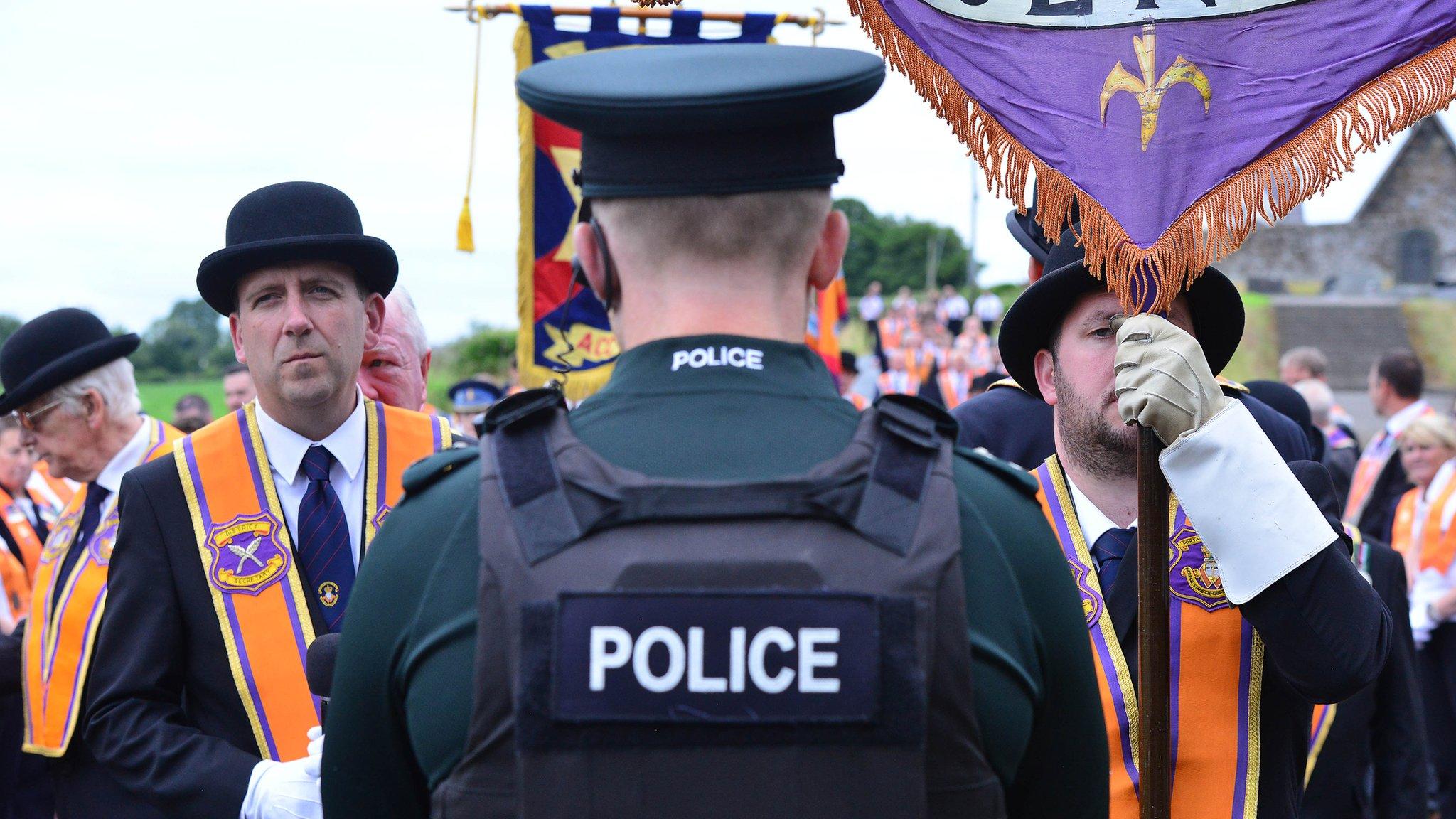Drumcree: The Garvaghy Road dispute 25 years on
- Published

Orange men find their part down the Garvaghy Road blocked by steel girders and razor wire 5 July 1998
Sunday marks 25 years since the attention of the world turned to a stretch of previously anonymous road in County Armagh.
In 1998, the newly-established Parades Commission ruled the Orange Order should not march down Portadown's Garvaghy Road on the end leg of its annual march from Drumcree Church.
About 1,000 police and 1,000 soldiers were deployed to enforce the decision.
It was a move that became a major flashpoint in Northern Ireland's troubled history, generating a bitter and sometimes violent standoff which is still being felt today.

Orange marchers approach the barricade that prevented them walking down the Garvaghy Road in 1999
The Orange Order - the most prominent of the 'loyal orders' associated primarily with Ulster Protestants - had been using the route as part of its traditional march every year on the last Sunday before 12 July.
However, over a number of years the route had become contentious, with protests from residents living along the mainly-nationalist Garvaghy Road.
Before 1998, there had been years when the Royal Ulster Constabulary (RUC) decided not to allow the march to go down the road, most notably in 1996.
However, following loyalist violence and disorder across Northern Ireland, a U-turn allowed 1,000 marchers to complete the route sparking subsequent rioting from nationalists.

Then Ulster Unionist leader David Trimble (left), with Sir Jeffrey Donaldson (now leader of the DUP) and the Reverend Martin Smyth at Drumcree in 1996
The issues at Drumcree, and other disputes over marches, led the government to set up the independent Parades Commission to find solutions.
It was the commission's ruling in 1998, mere weeks after the signing of the Good Friday Agreement pointed to a new future for Northern Ireland, that set the stage for a major confrontation.
Widespread trouble
The Army and RUC built a barricade on the road which links Drumcree Church with the Garvaghy Road and dug a trench, which was then lined with barbed-wire, through adjoining fields.
Despite the commission's ruling, the Orange Order maintained it would march down what it said was its traditional route.
On Sunday 5 July, those taking part in the parade left their service at Drumcree Church and marched up to the barricade, where the standoff began.

Soldiers install rows of razor wire in the fields surrounding Drumcree church
Over the following days, thousands of Orange Order members joined the marchers in Portadown to demand access to the road.
Widespread disorder broke out in Portadown and across Northern Ireland.
Speaking at the time, SDLP politician Brid Rodgers described the demonstration as "massive intimidation".
Reflecting on reporting that period, former BBC political editor Mark Devenport told Good Morning Ulster: "We had a build up. Obviously there had been significant tension in there in 1995, 96 and 97.

Soldiers and police officers confront protestors at Drumcree in 1998
"In those years, the Orangemen had been forced down (the road), eventually, by security forces pushing local residents off the Garvaghy Road.
"[In 1998] We then had this formation of a siege up by the church at Drumcree. Myself and the other members of the press, we took up a position just behind the police lines at the Garvaghy estate.
"What we witnessed over the next few days was like a medieval battle."
Between Saturday 4 July and Tuesday 14 July, there were more than 2,500 public order incidents recorded, according to RUC statistics in an Ulster University archive., external

Violence flared across Northern Ireland in the wake of the Parades Commission decision in 1998
Of these, 615 attacks were on members of the security forces, including 24 shooting incidents and 45 blast bombs.
Just over 140 houses were damaged in attacks during the violence across Northern Ireland.
But things were to get worse, with one of the most infamous incidents in the history of the Northern Ireland conflict.
Three children - Richard Quinn, 11, and his brothers Mark, nine, and Jason, eight - were killed in an arson attack on their home, external in Ballymoney, County Antrim.
One man was later convicted over their deaths. Police believed the attack was motivated by sectarianism, as the boys were part of a Catholic family living in a predominantly Protestant estate.

Richard, Mark and Jason Quinn (front row, pictured with their brother Lee) were killed in an arson attack
Their deaths created widespread revulsion, extending even as far as then US President Bill Clinton.
The Orange Order's County Armagh chaplain at the time, the Reverend William Bingham, called for the protest at Drumcree to come to an end, saying: "No road is worth a life, let alone the lives of three little boys."
"That, in the end, I think really took the pressure out of the Orange Order's case," Mr Devenport said.
"Whilst local Orange men want to complete their march even today, it's hard to imagine the sort of head of steam building that was there in the mid to late 1990s."
Then and now
Today, the eyes of the world are no longer on Drumcree and the heat has dissipated - but the issue does remain for the Orange Order.
The Portadown District Lodge said it is as "determined today as it was on 5 July 1998 to complete our return parade via the Garvaghy Road".
The lodge has attempted to make the march annually for the past 25 years, with the exceptions such as during the Covid pandemic - but every year has been denied permission by the Parades Commission.
Marchers make their way from the church down to a police cordon and then turn back.
A Portadown District Lodge spokesperson said the lodge has been ready to engage with Garvaghy Road residents since 2006, but this had not yet happened.

The Orange Order Drumcree march is turned away from going down the Garvaghy Road every year
The spokesperson added: "This parade has now become a legacy problem which needs to be completed via the traditional route in order for all the community in Portadown to move on."
This year, the Orange Order applied for a 3,000-person march on the Garvaghy Road - a larger-than-normal application to mark the 25th anniversary.
The application was knocked back by the Parades Commission.
While tensions do remain, community relations within Portadown have improved considerably since the peak of the Drumcree dispute.
The Reverend Gary Galway was initially hesitant when he was offered a post at Drumcree Parish Church.
"I made it clear at the start of it that I am not political. I will not get involved in the politics and I haven't done and I continue to do that," he told BBC News NI.
He has been in the parish for 15 years.
Mr Galway said there has been a growth in cross-community work with his church and the community along the Garvaghy Road.
Describing one project, he said: "There's a group of young fellas that come along. They don't have a trade or they don't have any qualifications as such, so we take them on for a day and do practical work in the community.
"From 25 years ago to today, there's been a big shift and long may that continue."
Related topics
- Published11 July 2012

- Published29 June 2023

- Published6 July 2023
